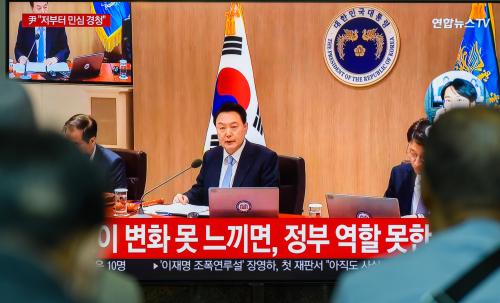After a year in which Arab politics dominated the news, the issue of Iran has roared back into the headlines thanks to a series of provocative moves by Tehran and the intensification of U.S. partisan jousting over foreign policy. As I discuss in my chapter “Iran: The Bogeyman” in The Arab Awakening: America and The Transformation of the Middle East, Iran’s Islamic Republic has largely escaped the direct impacts of the popular agitation for greater accountability and representative rule that has swept the broader Middle East over the past year. And yet the Arab awakening has had a profound influence on Iran by virtue of the transformation of the region and the new imperatives that this entails for U.S. policy toward Tehran. Iran’s theocracy may have withstood the tidal wave of change thus far, but the turmoil around it has cast the threat posed by the Iranian regime in sharp relief for its neighbors and for Washington.
A year after the collapse of the Tunisian and Egyptian autocracies, Iran’s internal political landscape appears eerily untouched. The authorities have successfully quashed any popular inclination toward public protest; even as news of severe new U.S. sanctions has sent Iran’s currency into a free-fall, there is little evidence that Iran’s disproportionately young and underemployed population is prepared to rally on the streets. The once-potent Green Movement has been effectively decapitated by Tehran’s cold-blooded tactics, including the house arrest of its leading figureheads, and its many advocates-in-exile predictably have become locked in futile squabbling. The most dynamic political debate within Iran today is not among its opposition, but its hard-liners, who are engaged in unrestrained internecine warfare. In other words, the Islamic Republic’s current domestic landscape remains frozen in the general patterns reliably exhibited since the 1979 revolution: fierce struggles among the political elite overshadowing a quiescent but deeply dissatisfied citizenry.
Still, the regional events of the past year cast a dramatic shadow for Iran’s domestic evolution. It is still too soon to pronounce a verdict on the net effect of the Arab spring for Iran’s internal politics—whether the movement can offer an inspiration or even a blueprint for Iranian activists, whether the intensification of its paranoia and the erosion of its regional soft power will ultimately doom the revolutionary theocracy. The Arab transitions are being watched closely within the Islamic Republic, both by its skittish leadership and its frustrated population. The most consequential of these will be Egypt, whose struggles to translate the eviction of an autocrat into a meaningful democracy evokes the binary hopes and fears of Iranian democracy advocates and their regime opponents.
However, for Washington and the region, the Arab spring necessitated a dramatic shift in its policy toward Tehran. Should public demonstrations erupt this spring, when Iran undergoes parliamentary elections, it is utterly inconceivable that the Obama Administration could maintain the detachment that characterized its response to Iran’s historic June 2009 protests. Moreover, the Arab spring’s elevation of democracy within the hierarchy of U.S. interests in the Middle East now has implications for Washington’s future options on the nuclear program. Two years ago, only months after Tehran violently subdued election protests, Secretary of State Hillary Clinton explicitly subordinated the democracy question in hopes of gaining traction for a nuclear deal with Tehran, declaring that “we encourage the free expression of ideas and political choices, but this nuclear program really is the core of our concern right now.” In the aftermath of the Arab spring, such an official articulation of hard-nosed realism sounds profoundly unseemly.
For Iran’s neighbors, the regional turmoil has also reshaped their approach to the Islamic Republic, intensifying the deeply-held trepidations that emanate from strategic competition as well as ethnic and sectarian differences. The Gulf states’ cold peace with Iran has relapsed into another cold war, as Saudi Arabia and the smaller emirates have sought to preserve the status quo amidst an environment of regional flux. So far the Obama administration has embraced the fruits of this revived regional confrontation, including unprecedented multilateral cooperation among the Gulf states and lucrative new arms packages that benefit U.S. companies. However, the past year should serve as a reminder of the unpredictable course of Middle East politics. The eruption of an existential contest for influence between Riyadh and Tehran—two states with sectarian impulses, little tolerance for democracy, and vital significance for the world economy—appears almost certain to incite volatile future repercussions for U.S. interests and international security.


Commentary
The United States and Iran: The Arab Awakening Changes Everything
January 4, 2012